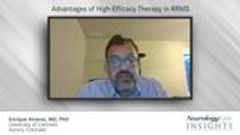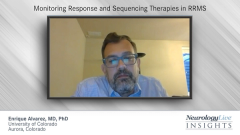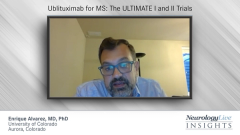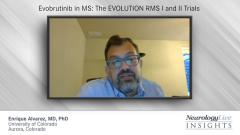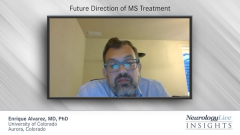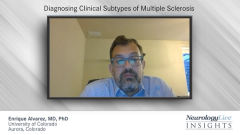
Advantages of High-Efficacy Therapy in RRMS
Key opinion leaders in neurology, Lawrence Steinman, MD and Enrique Alvarez, MD, PhD examine some advantages associated with beginning patients on higher-efficacy therapies for relapsing/remitting multiple sclerosis.
Episodes in this series

Lawrence Steinman, MD: Some of the important markers include how the patient is doing, how many attacks they’ve had, and what their level of disability is at any given time. We have an armamentarium of drugs that include oral medications that are highly efficacious, and then biologics that are given either by infusion or subcutaneous injection that are able to stop the accumulation of new lesions quite impressively—over 90%—and also shut down the relapses nearly completely. Each of these medications has their own issues with safety, but the benefits far outweigh the risks of complications that we’re aware of.
The high efficacy agents include drugs that are taken orally as well as drugs that need infusion or supervision. When there is reluctance on the part of practitioners, it has to do with older ways of thinking that you should start with the mildest drugs and work up to the strongest drugs. These days, we realize that the benefits far outweigh the safety issues on the stronger drugs. They are also more effective than the milder drugs. I can’t speak for the mindset of somebody who would ascribe to the philosophy that I am not fond of, that there is any reason to begin with mild drugs and build up. This is a serious disease, and intervening early and strongly makes logical sense to me. All I can do with my colleagues who ascribe to a different philosophy is be patient and persistent in listening to why they might think that. But personally, I think it’s misguided.
Enrique Alvarez, MD, PhD: There are a few things I like about involving high efficacy therapies early for a lot of our patients. In our center, at least 80% of my patients will start with a high efficacy therapy early. There are a few things I like about this approach. After about a year or two, after you get past the diagnosis and the patients start to become stable, there’s a peace of mind that happens at the appointment that is hard to duplicate with some of the other therapies. Sometimes there’s a letdown when a patient who’s stable for a year or two then develops new MRI lesions and you have to change therapy. Patients who are on high efficacy therapy usually start a treatment, and by the time you find out that they tolerate it within a few months after 1 or 2 stable MRIs, they like the idea of being able to stay on that therapy. The chances of being able to stay on that therapy is much more common with higher efficacy therapies.
Then patients pretty much start to forget they have this disease. They show up for their infusions or their treatments, and they’re done. There’s a reassurance I really like about the approach. I often get asked how I select patients for this approach. My off-the-cuff response is that they have a heartbeat. What I mean by this is that even patients with very mild disease are good candidates for high efficacy therapy. Even if they have an optic neuritis and a couple of lesions and you’ve made the decision to treat for MS [multiple sclerosis], even though they might have all the great prognostic factors, they may not be great candidates for taking a pill twice a day or even once a day if they’re not going to take pills. But they might be great candidates for a therapy that involves infusions just twice a year. Not eliminating options becomes important, and it’s that discussion that helps in deciding which patients might be good candidates for these therapies.
There are a lot of data that suggest that high efficacy therapies are a better treatment strategy. We’ve been involved with some observational studies. There’s a great series of research coming out from the MSBase databases. I’ll use some examples from a recent publication we had that looked at a comparison of rituximab vs natalizumab vs fingolimod vs dimethyl fumarate that followed patients for at least 2 years. If we look at patients who had disease activity at 2 years, we see that about 15% of patients on rituximab had either new MRI lesions, a relapse, or some concern for disease activity. That number became about 25% on natalizumab, which is very similar statistically between those 2 groups.
But in the orals, fingolimod and dimethyl fumarate, by 2 years it was about 40% to 45%. To demonstrate my point about the comfort level that appears with time, the vast majority of that was by the first year. We could see that about 30% or 35% of patients by 1 year had that disease activity and were stable for that second year. The vast majority of disease activity happens in the first 6 to 12 months. After that, there is a stability that becomes really important for both patients and providers.
As we look at disability, we can look at some data sets from the MS database that also looked at some Swedish data. In a study that included disability data, those who were on high efficacy therapy had EDSS [Expanded Disability Status Scale] measured. Two on that scale is fairly mild disability. Most of these patients had a beginning disability level of about 2.2 or 2.1 in those who started with more of an escalation approach. By 10 years, there wasn’t much of a change at all in those who started with a high efficacy therapy, with an EDSS in this group of about 2.3. Those who had started with more of an escalation approach had their EDSS go up to about 3.5. That isn’t a huge jump, but it suggests that we’re starting to accumulate disability in patients who fail treatment and need to be switched. The anxiety and stress of having to switch therapies, especially in the United States where you have to deal with insurance companies, becomes really important. Trying to provide as much reassurance as we can is helpful. We can provide an easier time with that with higher efficacy therapies.
Transcript Edited for Clarity
Newsletter
Keep your finger on the pulse of neurology—subscribe to NeurologyLive for expert interviews, new data, and breakthrough treatment updates.


